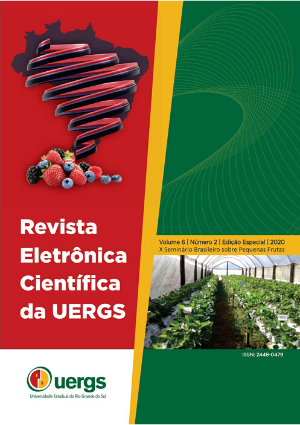Desenvolvimento de doces cremosos de mirtilo e framboesa com polpa de Gila
DOI:
https://doi.org/10.21674/2448-0479.62.132-136Keywords:
Aceitação. Análise Sensorial. Antocianinas. Polifenóis Totais.Abstract
Blueberries and raspberries are small fruits rich in phenolic compounds and antioxidant properties, which are catching the preference of producers and consumers. While gila squash is an unconventional vegetable with anti-glycemic properties, it is still underexplored commercially. The objective of this work was to develop creamy blueberry and raspberry candies, with the addition of different gila proportions, as a way to reduce production costs without altering the sensory acceptance of the creamy jellies. The experiment was carried out at the headquarters of Universidade Estadual do Rio Grande do Sul, Encantado RS unit. Different ratios of gila pulp (0, 10, 15 and 20%) were added in blueberry and raspberry jams. The candies were submitted to sensory and physicochemical analyzes of anthocyanins and total polyphenols. The blueberry ones, besides not presenting difference in the total polyphenols concentration and sensory acceptance, also resulted in higher concentration of anthocyanins, due to the addition of gila. Raspberry had significant differences in sensory evaluation and reduction of anthocyanin concentration, but no reduction in total polyphenol concentration. It was concluded that the addition of gila pulp is a viable option for making blueberry and raspberry creamy sweets as a way to reduce costs without significantly altering product acceptance.
Downloads
References
GUIMARÃES, I. C. Tecnologias para conservação e processamento de framboesa (Rubus idaeus), 2012, 159 p. Dissertação (Mestrado). Universidade Federal de Lavras (UFL), Lavras, 2012. Disponível em: http://repositorio.ufla.br/bitstream/1/1176/1/DISSERTA%C3%87%C3%83O_Tecnologias%20para%20conserva%C3%A7%C3%A3o%20e%20processamento%20de%20framboesa%20%28Rubus%20idaeus%29.pdf. Acesso em: 09 Set. 2018.
GUIMARÃES, D. H. P. et al. Geleia de mirtilo (Blueberry): análises dos parâmetros sensoriais e do efeito do armazenamento nas propriedades físicas e químicas. Revista Brasileira de Pesquisa em Alimentos (REBRAPA). [Campo Mourão], v. 5, n. 1, p. 19–25, 2014. Disponível em: http://cm.utfpr.edu.br/files_old/files/journals/1/articles/150/attachment/150-883-1-AT.pdf. Acesso em: 26 Maio 2018.
INSTITUTO ADOLFO LUTZ. Métodos físico-químicos para analise de alimentos. 4. ed. São Paulo, 2008. Disponível em: http://www.ial.sp.gov.br/resources/editorinplace/ial/2016_3_19/analisedealimentosial_2008.pdf. Acesso em: 28 de Jun. 2018.
LOVATTO, M. T. Agroindustrialização de frutas I. Santa Maria: Universidade Federal de Santa Maria, Colégio Politécnico, Rede e-Tec Brasil, 2016. Disponível em: http://estudio01.proj.ufsm.br/cadernos_fruticultura/sexta_etapa/arte_agroindustrializacao_de_frutas_I.pdf. Acesso em: 28 Maio 2018.
PRIORI, D. et al. Abóbora-gila (cucurbita ficifolia), uma hortaliça pouco convencional cultivada no Rio Grande do Sul . Pelotas: Embrapa Clima Temperado, 2010. 20 p. Disponível em: https://ainfo.cnptia.embrapa.br/digital/bitstream/item/78979/1/documento-320.pdf. Acesso em: 02 Abr. 2018.
ROCHA, F. I. G. Avaliação da cor e da atividade antioxidante da polpa e extrato de mirtilo (Vaccinium myrtillus) em pó. 2009. 93 f. Dissertação (Mestrado). Universidade Federal de Viçosa. Viçosa, 2009. Disponível em: http://www.locus.ufv.br/bitstream/handle/123456789/2865/texto%20completo.pdf?sequence=1. Acesso em: 10 Nov. 2018.
RUFATO A. D. R ; ANTUNES L. E. C. (Ed.). Técnicas de produção de framboesa e Mirtilo. Brasília: Embrapa Clima Temperado, 2016. Disponível em: https://www.embrapa.br/busca-de-publicacoes/-/publicacao/1074452/tecnicas-de-producao-de-framboesa-e-mirtilo. Acesso em 16 Nov. 2018.
Downloads
Published
How to Cite
Issue
Section
License
A reprodução total dos artigos da Revista em outros meios de comunicação eletrônicos de uso livre é permitida de acordo com a licença Creative Commons Atribuição-NãoComercial-CompartilhaIgual 4.0 Internacional.

